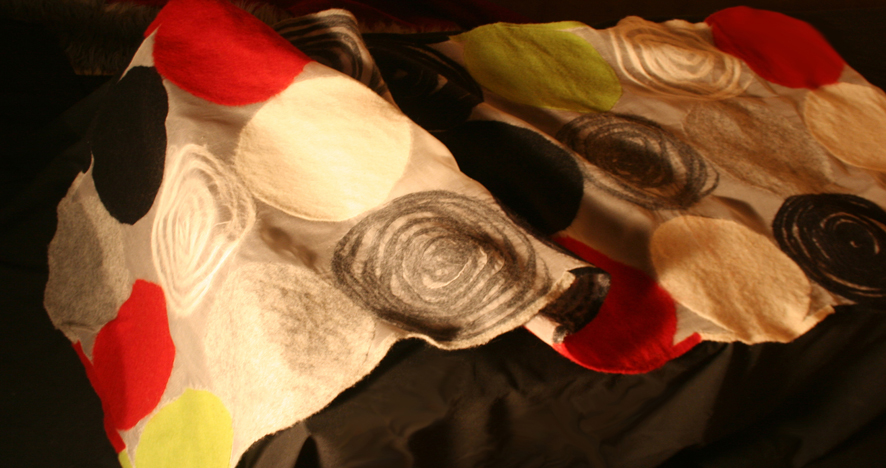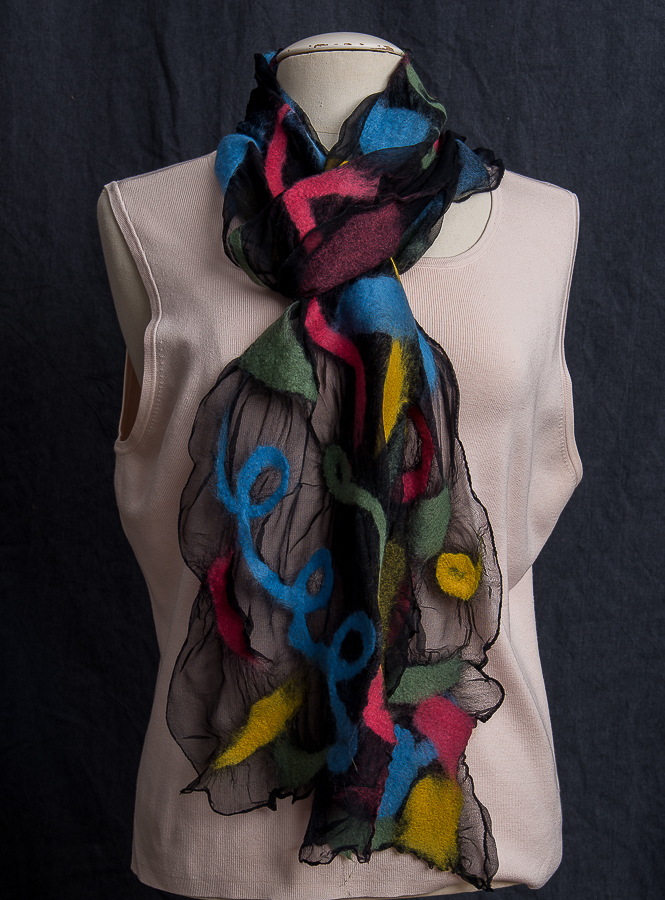Nuno Felting on:
[Wikipedia]
[Google]
[Amazon]

 Nuno felting is a fabric
Nuno felting is a fabric
Maria Livesey
(ne Grant), an undergrad student of Textiles at Gary's School of Art, Aberdeen, around 1993. The name "Nuno" is derived from
 Nuno felting creates a highly versatile fabric. It can be made in many weights to accommodate many different uses. It can be made much lighter in weight than traditional all-wool felt, accounting for its movement and drape. Because of the range of weights possible with the cloth very diverse garments can be made.
A lightweight Nuno fabric is made by laying one layer of loose fiber onto an open weave fabric base, creating a lightweight material. A much heavier Nuno fabric results from applying more layers, usually 3-4, of loose fibers onto an open weave base creating fabric ideal for a winter coat or scarf.
Nuno felting creates a highly versatile fabric. It can be made in many weights to accommodate many different uses. It can be made much lighter in weight than traditional all-wool felt, accounting for its movement and drape. Because of the range of weights possible with the cloth very diverse garments can be made.
A lightweight Nuno fabric is made by laying one layer of loose fiber onto an open weave fabric base, creating a lightweight material. A much heavier Nuno fabric results from applying more layers, usually 3-4, of loose fibers onto an open weave base creating fabric ideal for a winter coat or scarf.




 Nuno felting is a fabric
Nuno felting is a fabric felt
Felt is a textile that is produced by matting, condensing, and pressing fibers together. Felt can be made of natural fibers such as wool or animal fur, or from synthetic fibers such as petroleum-based acrylic fiber, acrylic or acrylonitrile or ...
ing technique developed by Polly Stirling, a fiber artist from New South Wales, Australia
New South Wales (commonly abbreviated as NSW) is a state on the east coast of :Australia. It borders Queensland to the north, Victoria to the south, and South Australia to the west. Its coast borders the Coral and Tasman Seas to the east. T ...
around 1992. While being explored on the other side of the globe bMaria Livesey
(ne Grant), an undergrad student of Textiles at Gary's School of Art, Aberdeen, around 1993. The name "Nuno" is derived from
Japanese
Japanese may refer to:
* Something from or related to Japan, an island country in East Asia
* Japanese language, spoken mainly in Japan
* Japanese people, the ethnic group that identifies with Japan through ancestry or culture
** Japanese diaspor ...
(布) and means cloth.Ziek, B. (2004). The felt frontier: I: Polly Stirling: Contemporary feltmaker. Surface Design Journal, 28(4), 35-38
Technique
The technique used in Nuno felting bonds loose fiber (usually sheep'swool
Wool is the textile fiber obtained from sheep and other mammals, especially goats, rabbits, and camelids. The term may also refer to inorganic materials, such as mineral wool and glass wool, that have some properties similar to animal w ...
) into a sheer fabric, such as silk
Silk is a natural fiber, natural protein fiber, some forms of which can be weaving, woven into textiles. The protein fiber of silk is composed mainly of fibroin and is most commonly produced by certain insect larvae to form cocoon (silk), c ...
gauze, creating a lightweight felt. Other fibers are also used to create different surface textures. Other fibers used include wool from camel
A camel (from and () from Ancient Semitic: ''gāmāl'') is an even-toed ungulate in the genus ''Camelus'' that bears distinctive fatty deposits known as "humps" on its back. Camels have long been domesticated and, as livestock, they provid ...
, llama
The llama (; or ) (''Lama glama'') is a domesticated South American camelid, widely used as a List of meat animals, meat and pack animal by Inca empire, Andean cultures since the pre-Columbian era.
Llamas are social animals and live with ...
, alpaca
The alpaca (''Lama pacos'') is a species of South American camelid mammal. Traditionally, alpacas were kept in herds that grazed on the level heights of the Andes of Southern Peru, Western Bolivia, Ecuador, and Northern Chile. More recentl ...
, Mohair goat, Cashmere goat
A cashmere goat is a type of goat that produces cashmere wool, the goat's fine, soft, downy, winter undercoat, in commercial quality and quantity. This undercoat grows as the days get shorter and is associated with an outer coat of coarse hair, w ...
, yak, and rabbit
Rabbits are small mammals in the family Leporidae (which also includes the hares), which is in the order Lagomorpha (which also includes pikas). They are familiar throughout the world as a small herbivore, a prey animal, a domesticated ...
fur.
Those fibers can completely cover the background fabric, or they may be used as a decorative design that allows the backing fabric to show. Nuno felting often combines several layers of loose fibers to build up the finished fabric color, texture, and design elements.
The felting process is particularly suitable for creating lightweight fabrics used to make clothing. The use of silk or other stable fabric in the felt creates a fabric that will not stretch out of shape. Fabrics such as nylon
Nylon is a family of synthetic polymers characterised by amide linkages, typically connecting aliphatic or Polyamide#Classification, semi-aromatic groups.
Nylons are generally brownish in color and can possess a soft texture, with some varieti ...
, muslin
Muslin () is a cotton fabric of plain weave. It is made in a wide range of weights from delicate sheers to coarse sheeting. It is commonly believed that it gets its name from the city of Mosul, Iraq.
Muslin was produced in different regions o ...
, or other open weaves can be used as the felting background, which results in varying textures and colors.
 Nuno felting creates a highly versatile fabric. It can be made in many weights to accommodate many different uses. It can be made much lighter in weight than traditional all-wool felt, accounting for its movement and drape. Because of the range of weights possible with the cloth very diverse garments can be made.
A lightweight Nuno fabric is made by laying one layer of loose fiber onto an open weave fabric base, creating a lightweight material. A much heavier Nuno fabric results from applying more layers, usually 3-4, of loose fibers onto an open weave base creating fabric ideal for a winter coat or scarf.
Nuno felting creates a highly versatile fabric. It can be made in many weights to accommodate many different uses. It can be made much lighter in weight than traditional all-wool felt, accounting for its movement and drape. Because of the range of weights possible with the cloth very diverse garments can be made.
A lightweight Nuno fabric is made by laying one layer of loose fiber onto an open weave fabric base, creating a lightweight material. A much heavier Nuno fabric results from applying more layers, usually 3-4, of loose fibers onto an open weave base creating fabric ideal for a winter coat or scarf.



References